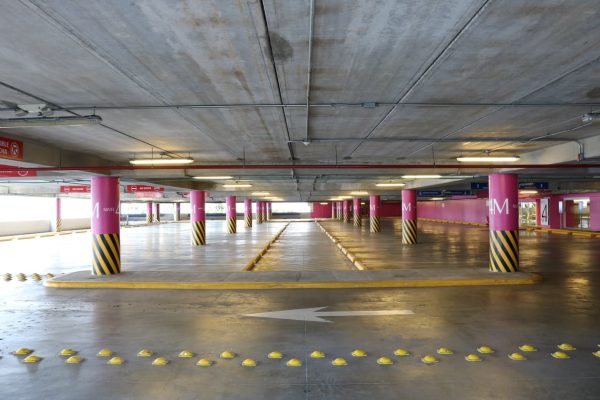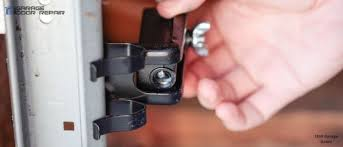Insulated garage door panels are an essential component for preserving a comfortable indoor temperature and minimizing unwanted outdoor noise in garages. The process of constructing these panels is carried out by professional manufacturers using a meticulous step-by-step approach. If you’re intrigued by the intricate process of how these durable panels are crafted, you’re not alone. We provide an in-depth overview of the entire process involved in creating these sturdy panels.
An Overview of Garage Door Panel Materials
Insulated garage door panels consist of three main components:
- The exterior steel skins
- The insulation core
- The support braces
The exterior skins are made from high-tensile steel, usually 25-27 gauge thickness. They form the outer layer and provide strength and durability. Galvanized steel is often used for its resistance to rust and corrosion.
The core insulation fills the space between the two exterior panes. It provides thermal and sound insulation. Common insulations used are polyurethane foam, polystyrene foam and fiberglass batting. Polyurethane is popular for its high R-value (insulation ability) compared to thickness.
Support braces, made from galvanized steel, are embedded into the insulation to connect the two exterior steel sheets. They add structural rigidity to the panel.
Now that we’ve covered the key materials, let’s look at how they’re fabricated into a complete garage door panel.
How Insulated Garage Door Panels Are Manufactured
Constructing an insulated garage door panel is a multi-stage process automated by advanced factory machinery. Each panel passes through several special machines during the fabrication process. Here are the 6 main steps:
1. Cutting The Exterior Steel Skins
The first stage is to cut the exterior steel skins to size. This is done by a large mechanized steel coil slitter. Steel sheeting comes to the factory in giant coils weighing up to 10 tons.
The automated slitter has circular blades that unwind the coil and slice it into narrower strips with precision. A typical panel may need two 24″ wide steel sheets cut to length.
Once cut, the sheets move to the next machine for further processing.
2. Adding Structural Braces
Next, galvanized steel support braces are welded onto the back of one of the exterior sheets. The braces will run horizontally across the panel to provide rigidity. They also create a pocket for the insulation foam to be injected between the sheets.
The support brace attachment is automated via robotic welders. The pre-cut braces are auto-fed into the welder and securely fused to the steel sheet. With machines doing the welding, the whole process takes just minutes versus hours of manual work.
3. Inserting Insulation Core
At this stage, the steel sheets pass through an injection machine that fills the space between them with expandable foam insulation.
Polyurethane is a common choice as it expands 30 times its liquid volume into a hardened rigid foam. Liquid chemicals are precisely measured, combined and injected between the sheets.
Within minutes, the chemicals react and expand to totally fill the interior space. The foam hardens into a dense insulation core bonded to the steel surfaces.
Fiberglass batts are another option. They can be inserted manually or by automated mechanical means. The unfaced batts simply fit into place between the sheets.
4. Sealing and Bonding
Next, the composite panel passes through pinch rollers. This seals and bonds the expandable foam or fiberglass core between the steel skins.
The heavy rollers apply pressure and compression to fuse the materials into a tight, rigid unit. The core insulation is now locked permanently in place within its steel surroundings.
This makes the panel highly resilient and stable, preventing insulation sag over years of use.
5. Shaping the Panel
After sealing and bonding, the panel moves to the forming press. This large machine contains top and bottom dies that stamp the panel into its final shaped form.
Different panel styles have different shaped dies – raised, flush, long or short. The automated press clamps down under high pressure, bending the panel to match the die forms.
This gives the insulated panel its final dimensional form. The panel can now provide the right contour and profile when installed onto a sectional garage door.
6. Cutting Completed Panels
The last step is to cut the panel to its final length. Automated circular saws trim the panel precisely to size based on the garage door model.
Cutouts for windows, handles or decor may also be cut at this point. The finished insulated panel is now ready for painting, final assembly and shipping.
Painting and Finishing Insulated Panels
Before installation, insulated panels usually get painted or coated for aesthetics and protection. There are a few different finishing methods:
- Pre-painted steel – Some manufacturers use pre-painted steel skins. The steel arrives pre-coated in the desired color, avoiding the need to paint later. This ensures consistent, durable color that won’t chip or peel.
- Post-painting – Panels may get spray painted after fabrication. Automated paint lines convey panels through special spray stations. The precision equipment applies an even, consistent coat of liquid paint. After drying, the panels have a durable factory-finished look.
- Vinyl overlays – For a wood-like look, manufacturers bond thin vinyl sheets to the exterior steel skins. The decorative vinyl overlays mimic the look of expensive wood garage doors at a fraction of the cost. Automated processes press the vinyl onto the panels for reliable adhesion.
- Faux woodfinishes – Some brands apply faux woodgrain textures and colors onto steel panels. This gives the attractive look of wood with the strength and affordability of steel. The woodgrain pattern may get rolled onto special paint coatings on the assembly line.
So in summary, various automated processes can apply protective and decorative final finishes to the completed insulated panels. This saves time versus manual painting and ensures consistent coatings.
Assembling the Complete Garage Door
The fully fabricated insulated panels are now ready to get installed into a full sectional garage door system. Here’s how the assembly process works:
- Hinges, rollers and cables get attached to the tops and bottoms of the panels. This creates a working joint that connects all the pieces.
- Sealants and weatherstripping get installed around the panel edges. This weatherproofs the joints from outside elements like wind, rain and snow.
- Decorative windows, handles, locks and other hardware are fastened onto the panels if included in the design.
- Strong steel stiles and rails are attached horizontally and vertically to hold panels together in a rigid sectional framework.
- Torsion springs get mounted to provide counterbalance lift assistance for opening and closing the door.
- Tracks and rollers are mounted for the door to move smoothly along the ceiling.
- Electric motor operators are installed on some doors for automatic opening and closing.
With all components in place, the full garage door can now operate as a cohesive system. It’s ready for professional installation and years of reliable service.
Benefits of Insulated Garage Door Panels
Now that you know how insulated garage door panels are made, let’s recap some of the benefits they provide:
- Thermal insulation – The insulated cores (polyurethane foam, polystyrene or fiberglass) provide excellent thermal resistance. This insulates your garage against outside temperatures, helping keep the interior cool in summer and warm in winter.
- Noise reduction – The thick insulation also dampens outside noise from entering your garage space. Activities inside the garage are less likely to disturb your home’s interior.
- Strength – The bonded steel skins make insulated panels incredibly rigid and durable. They stand up to dings, dents and weather better than single thin sheets.
- Lightweight – Despite their strength, insulated panels are lighter than solid wood or fibreglass doors. Lighter doors require smaller opener motors and springs.
- Affordability – Advanced manufacturing with steel skins and injected foam cores costs far less than wood doors. You get great insulation and durability for the money.
So in summary, insulated garage door panels give you the best of all worlds – effective insulation, soundproofing, strength and value. Understanding how they’re made helps explain why they last for years even in harsh climates.
Frequently Asked Questions
What is the typical thickness of insulated garage door panels?
Most insulated garage door panels range between 1-3 inches thick. Many standard models are 2 inches thick, providing good strength and insulation values. Custom doors can use thicker 3 inch panels for maximum insulation capability.
How much weight can insulated garage door panels support?
Thanks to their bonded steel skins and braces, insulated panels are very strong. Many standard panels can support over 100 pounds per square foot. Heavy-duty custom models reinforce panels to support over 200 pounds if needed for unusually large or heavy doors.
How long should insulated panels last?
Quality insulated steel garage door panels typically last 15-20 years or more. With proper maintenance and avoiding damage, some insulated panels continue functioning well for 25-30 years before needing full replacement. Their steel construction resists flexing, warping and decay over time.
Can you replace just one damaged panel?
In many cases, yes – individual damaged garage door panels can be replaced if needed. Unless it’s an exterior end panel, the middle panels can usually be swapped out. This just requires disconnecting and reconnecting the hinges and cables. Matching the panel size, style and color is important for a uniform appearance.
Should you paint insulated steel garage door panels?
Painting is an option but rarely needed. Factory applied finishes usually last many years. If repainting, use 100% acrylic latex paint compatible with galvanized steel. Avoid oil-based alkyd paints. Prepare with good cleaning and apply 2-3 thin coats for best adherence and durability.
Conclusion
Constructing insulated garage door panels is a complex process that demands advanced manufacturing techniques. But the result is a durable, reliable product that withstands years of heavy use in all climates. When selecting a quiet garage door opener, consider the precision automated production that ensures consistent quality and affordability, mirroring the amazing technology embedded in insulated garage doors. With proper installation and maintenance, you can rely on those sturdy insulated panels to keep your garage comfortable and secure for over 15 years in most cases.






